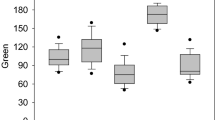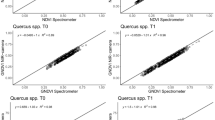Abstract
Population of the rare and endangered species Ammopiptanthus mongolicus (Maxim.) Cheng f. declined rapidly in China’s arid region and Central Asia. There is an urgent need to protect this species, which is particularly important in maintaining biodiversity throughout the arid region of northwestern China. By analyzing the infrared thermal images based on plant-transpiration transfer coefficient (h at) and photosynthetic parameters, we made quantitative and accurate diagnoses of the plant growth and health status of A. mongolicus. Using an LI-COR6400 photosynthesis system, we measured the net photosynthetic rate (P n), stomatal conductance (G s), and transpiration rate (T r). Infrared thermal images obtained in the field were processed by ENVI4.8 software to calculate surface temperatures of the plant subjects. We found that the plant transpiration transfer coefficient of A. mongolicus was in the order of old plants >young plants >intermediate-aged plants. Declining health levels of young, intermediate, and old plants were divided into three categories: <0.4, 0.4–0.7, and >0.7. The coefficient showed a significant negative correlation with T r, G s, and P n, indicating that they can simultaneously reflect the state of plant growth. By establishing hat and photosynthetic parameters in regression model Y = a-blnx, we can accurately diagnose plant growth and decline of plant health conditions.



Similar content being viewed by others
References
Bettina B, Boris P, Mark T (2010) High-throughput shoot imaging to study drought responses. J Exp Bot 61:3519–3528
Bond-Lamberty B, Wang C, Grower ST (2003) The use of multiple measurement techniques to refine estimates of conifer needle geometry. Can J For Res 33:101–105
Chaerle L, Van der Straeten D (2000) Imaging techniques and the early detection of plant stress. Trends Plant Sci 5:495–501
Chen NL, Tao YH (2003) Study on photosynthetic property of Cucurbita maxima. Acta Bot Boreali-Occident Sin 23:976–981
Dai JM, Gao HY, Zou Q (2004) Changes in activity of energy dissipating mechanisms in wheat flag leaves during senescence. Plant Biol 6:171–177
Davies WJ, Zhang J (1991) Root signals and the regulation of growth and development of plants in drying soil. Ann Rev Plant Physiol Plant Mol Biol 42:55–76
Giuseppe R, Shamaila Z, Wolfram S, Ciro S, Jill C, Jose LA, Joachim M (2011) Use of thermography for high throughput phenotyping of tropical maize adaptation in water stress. Comput Electron Agric 79(1):67–74
Greer DH, Halligan EA (2001) Photosynthetic and fluorescence light responses for kiwifruit leaves at different stages of development on vines grown at two different photon flux densities. Aust J Plant Physiol 28:373–382
He HB, Zhang HJ, Jia GX (2006) Population structure and spatial distribution pattern of Ammopiptanthus mongolicus in Dengkou County, Inner Mongolia autonomous region. Sci Silvae Sin 42(10):13–18
Hou P, Yin LK, Yan C (1994) Study on biomass of Ammopiptanthus mongolicus. Arid Zone Res 11(1):16–22
Huo H, Wang CK (2007) Effects of canopy position and leaf age on photosynthesis and transpiration of Pinuskoraiensis. Chin J Appl Ecol 18(6):1181–1186
James RA, Caemmerer SV, Condon AG, Zwart AB, Munns R (2008) Genetic variation in tolerance to the osmotic stress component of salinity stress in durum wheat. Funct Plant Biol 35:111–123
Jiang CD, Li PM, Gao HY, Zou Q (2005) Enhanced photoprotection at the early stages of leaf expansion in field-grown soybean plant. Plant Sci 168:911–919
Jones HG (1999) The use of thermography for quantitative studies of spatial and temporal variation of stomatal conductance over leaf surfaces. Plant, Cell Environ 22:1043–1055
Jones HG (2004) Irrigation scheduling: advantages and pitfalls of plant- based methods. J Exp Bot 55:2427–2436
Leinonen I, Jones HG (2004) Combining thermal and visible imagery for estimating canopy temperature and identifying plant stress. J Exp Bot 55:1423–1431
Liu GH (1998) Study on the endangered reasons of Ammopitanthus mongolicus in the desert of Alashan. Bull Bot Res 18(3):341–345
Meola C, Carlomagno GM (2004) Recent advances in the use of infrared thermography. Meas Sci Technol 15:27–58
Merlot S, Mustilli AC, Genty B, North H, Lefebvre V, Sotta B, Vavasseur A, Giraudat J (2002) Use of infrared thermography to isolate Arabidopsis mutants defective in stomatal regulation. Plant J 30:601–609
Omasa K, Takayama K (2003) Simultaneous measurement of stomatal conductance, non-photochemical quenching, and photochemical yield of photosystem II in intact leaves by thermal and chlorophyll fluorescence imaging. Plant Cell Physiol 44:1290–1300
Pan RC (2012) Plant physiology. Higher education press, Beijing
Qiu GY, Shi P, Wang L (2006a) Theoretical analysis of a soil evaporation transfer coefficient. Remote Sens Environ 101:390–398
Qiu GY, Wang S, Wu X, Song XF (2006b) Three temperature model (3T) model—a method to estimate evapotranspiration and evaluate environmental quality based on surface temperature IV. Plant transpiration transfer coefficient. J Plant Ecol 30(5):852–860
Qiu GY, Wang S, Wu X (2006c) Three temperature model (3T) model—a method to estimate evapotranspiration and evaluate environmental quality. J Plant Ecol 30(2):231–238
Qiu GY, Omasa K, Sase S (2009) An infrared-based coefficient to screen plant environmental stress: concept, test and applications. Funct Plant Biol 36:990–997
Ren LL, Gao HY (2008) Effects of NaCl stress on induction of photosynthesis and PS II photochemistry efficiency of rumex K-1 leaves with different age. Acta Bot Boreali-Occident Sin 28(5):1014–1019
Sauter A, Davies WJ, Hartung W (2001) The long-distance abscisic acid signal in the drougted plant: the fate of the hormone on its way from root to shoot. J Exp Bot 52(363):1991–1997
Schroeder JI, Kwak JM, Allen GJ (2001) Guard cell abscisic acid signaling and engineering drought hardiness in plants. Nature 410:327–330
Song YW, Kang YL, Liu H, Zhao XL, Wang PT, An GY, Zhou Y, Miao C, Song CP (2006) Identification and primary genetic analysis of Arabidopsis stomatal mutants in response to multiple stresses. Chin Sci Bull 51(21):2586–2594
Wang Y, Yin LK (1991) Measurement of salt tolerance of two species of Ammopitanthus mongolicus Maxim. Arid Zone Res 1:20–22
Wang B, Zhao GD, Li SN, Bai XL, Deng ZF (2005) Diurnal photosynthetic change characteristics of the dominant species Castanopsis fargesii and Castanopsis sclerophylla in evergreen broad-leaved forest in Dagangshan mountain, Jiangxi province. Acta Agric Univ Jiangxiensis 27(4):577–579
Wei QS, Wang JH, Li CL, Zhuang GH, Chen SK (2005) A preliminary study on the distribution patterns and characteristics of Ammopiptanthus mongolicus populations in different desert environments. Acta Phytoecol Sin 29(4):591–598
Xie ZQ, Chen WL, Jiang MX, Huang HD, Zhu RG (1995) A preliminary study on the population of Cathaya argyrophlla in Bamianshan mountain. Acta Bot Sin 37:58–65
Xie ZQ, Chen WL, Lu P, Hu D (1999) The demography and age structure of the endangered plant population of Cathaya argyrophlla. Acta Ecol Sin 19:523–528
Xu DQ (1990) Ecology, physiology and biochemistry of midday depression of photosynthesis. Plant Physiol Commun 6:5–10
Yan GQ, Zhao GF, Hu ZH, Yue M (2001) Population structure and dynamics of Larix chinenesis in Qinling mountain. Chin J Appl Ecol 12:824–828
Zhang T, Jiang ZR (1987) Study on introduction and cultivation test of Ammopitanthus mongolicus Maxim. J Desert Res 7(3):41–47
Zhou YJ, Liu CL, Feng JZ, Jia XH (2001) Advances of drought-resistance and frigid-resistance mechanism research on Ammopitanthus mongolicus. J Desert Res 21(3):312–316
Acknowledgments
We thank the West Ordos National Nature Reserve for its valuable assistance with manpower, materials, research, site selection, and other support.
Author information
Authors and Affiliations
Corresponding author
Additional information
Project funding
This work was supported by the national forestry nonprofit industry research projects of China, “Diagnosis of rare and endangered plants Ammopiptanthus mongolicus degradation and research of conservation technology” (No. 201304305).
The online version is available at http://www.springerlink.com.
Corresponding editor: Hu Yanbo.
Rights and permissions
About this article
Cite this article
Yuan, W., Yu, Y., Yue, Y. et al. Use of infrared thermal imaging to diagnose health of Ammopiptanthus mongolicus in northwestern China. J. For. Res. 26, 605–612 (2015). https://doi.org/10.1007/s11676-015-0075-3
Received:
Accepted:
Published:
Issue Date:
DOI: https://doi.org/10.1007/s11676-015-0075-3




